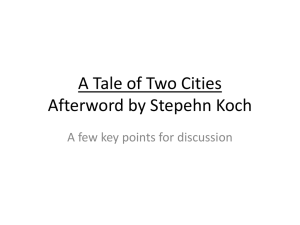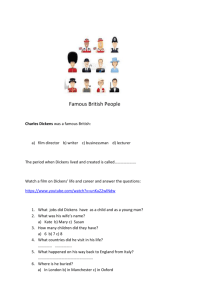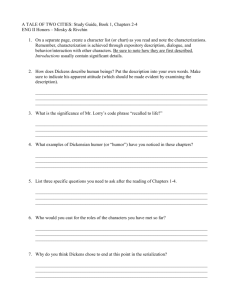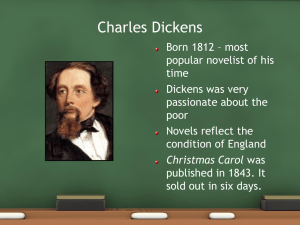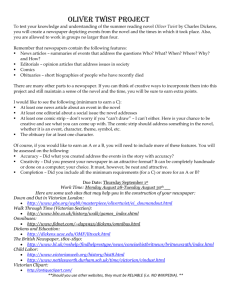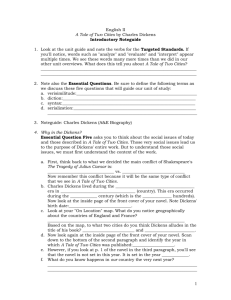Tale Extra Credit Essay.doc
advertisement
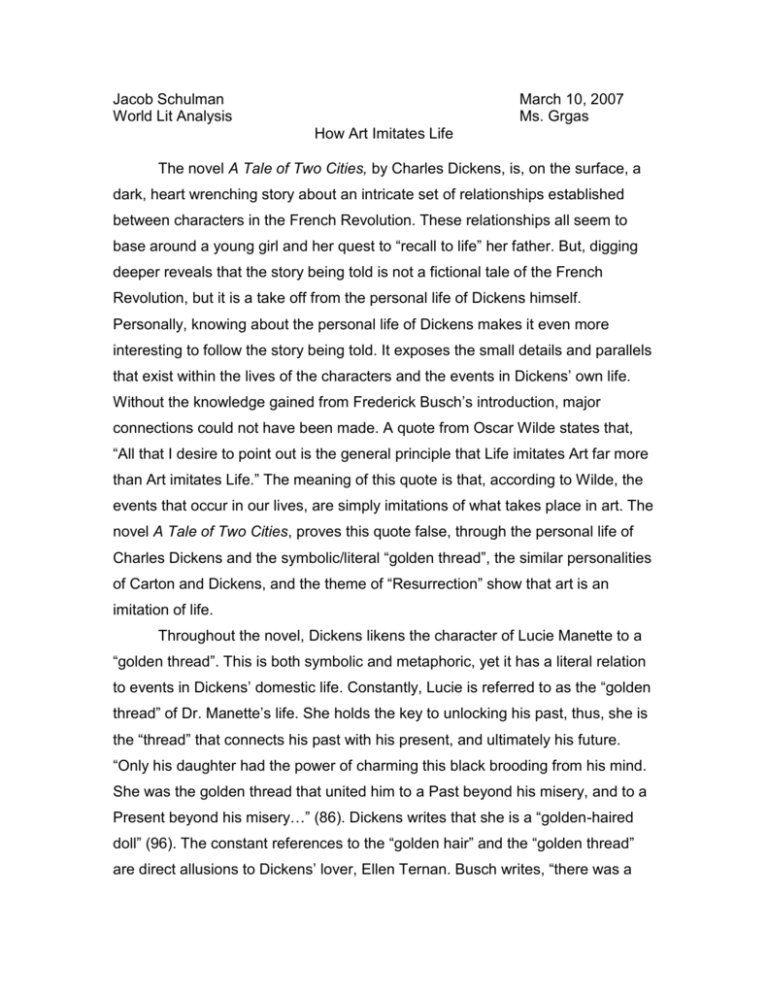
Jacob Schulman World Lit Analysis March 10, 2007 Ms. Grgas How Art Imitates Life The novel A Tale of Two Cities, by Charles Dickens, is, on the surface, a dark, heart wrenching story about an intricate set of relationships established between characters in the French Revolution. These relationships all seem to base around a young girl and her quest to “recall to life” her father. But, digging deeper reveals that the story being told is not a fictional tale of the French Revolution, but it is a take off from the personal life of Dickens himself. Personally, knowing about the personal life of Dickens makes it even more interesting to follow the story being told. It exposes the small details and parallels that exist within the lives of the characters and the events in Dickens’ own life. Without the knowledge gained from Frederick Busch’s introduction, major connections could not have been made. A quote from Oscar Wilde states that, “All that I desire to point out is the general principle that Life imitates Art far more than Art imitates Life.” The meaning of this quote is that, according to Wilde, the events that occur in our lives, are simply imitations of what takes place in art. The novel A Tale of Two Cities, proves this quote false, through the personal life of Charles Dickens and the symbolic/literal “golden thread”, the similar personalities of Carton and Dickens, and the theme of “Resurrection” show that art is an imitation of life. Throughout the novel, Dickens likens the character of Lucie Manette to a “golden thread”. This is both symbolic and metaphoric, yet it has a literal relation to events in Dickens’ domestic life. Constantly, Lucie is referred to as the “golden thread” of Dr. Manette’s life. She holds the key to unlocking his past, thus, she is the “thread” that connects his past with his present, and ultimately his future. “Only his daughter had the power of charming this black brooding from his mind. She was the golden thread that united him to a Past beyond his misery, and to a Present beyond his misery…” (86). Dickens writes that she is a “golden-haired doll” (96). The constant references to the “golden hair” and the “golden thread” are direct allusions to Dickens’ lover, Ellen Ternan. Busch writes, “there was a handsome, shy, intelligent eighteen-year-old with golden hair. Her name was Ellen Ternan…” (XI). Dickens knew that he could never be with her, as he was married and had nine children, but it didn’t stop him from symbolically representing her in arguably one of the greatest novels ever written. The art (literature) is directly imitating life (Dickens’ love for Ternan), and it adds another layer of complexity to the novel. The parallelism of the personalities of Sydney Carton and Charles Dickens is yet another example of how art can imitate life. Sydney Carton is the “jackal”. He is the man pulling the strings, doing all the dirty work, and, early in the novel at least, he is a depressed drunk. Dickens was also depressed in his life, but his love for Ellen Ternan helped him come back. The same goes for Carton, once he laid eyes on Lucie Manette, he fell in love, and declared that he would do anything for her, but that she could never be with him because he felt inferior to her. He declares this to her and tells her that one day he will sacrifice his life to save hers or of the ones she loves. This, of course, happens at the end of the novel, when Carton heads to the guillotine in place of Darnay. Frederick Busch writes that “Lucie Manette, daughterly and good and, to Sydney Carton, unattainable, and absolutely worty of the sacrifice of his life...and Ellen Ternan, I think, is much of Lucie Manette.” (XI). Carton needed a purpose in life, he needed to be recognized and have something to live for, just like Dickens. Dickens thought his life was wasted with his wife Catherine and their nine kids; Carton thought his was wasted with his drinking problems. “Dickens loved to perform publicly,” Busch writes, “whether in plays or readings of his works, for he could watch his audience read to his language and personality. He hungered for such reaction…” (X). Thus, the similarities in the personalities of Carton and Dickens in real life, show, once again, that art is an imitation of life, not the other way around. The theme of “Resurrection” in A Tale of Two Cities is another example of art imitating life. In the novel, many characters are resurrected: Dr. Manette, Roger Cly, and Charles Darnay. These characters are all resurrected in one way or another, be it literally, or figuratively. Dickens probably felt resurrected when he met Ellen Ternan, she was his saving grace, she gave him a reason to go on. She caused him to make drastic changes in his life: He left his magazine Household Words, and started anew. “Shining like the sun for both of them is a golden-haired woman.” (XI). The resurrection of Dickens in his marriage (which ended “under scandalous circumstances”, and the resurrection of the characters in the novel, are yet another major example of art imitating life. The connection between Lucie Manette as the “golden thread” and Ellen Ternan, the similar personalities of Sydney Carton and Dickens, and the theme of “Resurrection” are all examples of how art imitates life, thus proving the critical lens false. The additional information about the life of Charles Dickens makes A Tale of Two Cities even more enjoyable to read, as it adds yet another layer of intricacy to the meaning that Dickens is trying to portray. The hints and allusions made allow the novel to have some elements of an autobiography, while still remaining complex and detailed. The quote from Oscar Wilde, is false, because art, in this case literature, truly does imitate events that happen in our lives, and not the other way around. The subtle, and not so subtle hints given throughout the text are all meaningful when fully interpreted, and it makes the novel just that much more interesting and meaningful to read.

